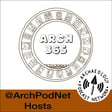Become a Creator today!Start creating today - Share your story with the world!
Start for free
00:00:00
00:00:01

Bath - Episode 18044
The Roman baths, in the City of Bath, England, are one of the best preserved roman bathing complexes in the United Kingdom.
Recommended
Transcript
Introduction to Roman Baths
00:00:01
Speaker
You're listening to the Archaeology Podcast Network. The Roman Baths in the city of Bath, England are one of the best preserved Roman bathing complexes in the United Kingdom. This is episode 44 for February 13, 2018.
About Arc 365 Podcast
00:00:18
Speaker
I'm Chris Webster and welcome to the Arc 365 podcast, 2018 edition. Arc 365 is a podcast today, every day in 2018.
Partnership with Tea Public
00:00:27
Speaker
The Archaeology Podcast Network has partnered with Tea Public to bring you some awesome gear that looks good, promotes archaeology, and puts a few pennies in our pockets so you can get free podcasts. Check out our designs at arkpodnet.com slash shop. That's arkpodnet.com slash shop.
Historical Significance of Bath's Hot Springs
00:00:41
Speaker
This episode is written by Christopher Booth. The hot springs at the city of Bath have a long history of human presence and exploitation due to the fact that hot water at a temperature of 46 degrees Celsius or 114.8 degrees Fahrenheit
00:00:53
Speaker
rises there at a rate of 1,170,000 liters or 257,000 imperial gallons every day. The first evidence for humans exploiting these hot springs are dated to the Iron Age when a Celtic shrine dedicated to the goddess Sulis was constructed.
00:01:08
Speaker
The Romans identified Sulus with their goddess Minerva, but continued to use the Celtic name after the invasion. This is why the Roman name for Bath was Aquasulus, the waters
Construction and Evolution of Roman Bathhouse
00:01:18
Speaker
of Sulus. The first Roman temple at the springs was constructed in 60-70 CE and the Bathhouse complex was expanded and remodeled over the next 300 years.
00:01:26
Speaker
A stable foundation in the mud was created in the 1st century CE and by the 2nd century a wooden barrel vaulted building at the site contained the calderium, hot bath, tepidarium, lukewarm bath, and frigidarium, cold bath. We did an episode on Roman hygiene practices including public baths earlier this year.
Restoration Efforts Over the Centuries
00:01:45
Speaker
After the withdrawal of Roman forces in the 5th century, the baths fell into disrepair and may have been deliberately dismantled in the 6th century, according to the Anglo-Saxon chronicle. Despite this, the hot springs had been used and remodeled many times over the centuries. In the 12th century, for example, John of Tours built a curative bath over the King's Spring Reservoir and in the 16th century, the City Corporation of Bath built a new bath, the Queen's Bath, to the south of the spring.
00:02:11
Speaker
The spring and baths are now housed in buildings built in the 18th and 19th centuries. In these centuries, visitors drank the waters in the Grand Pump Room and bathed in a re-established and expanding bathing complex.
Current Attractions at Roman Baths
00:02:22
Speaker
Modern visitors can see the baths, which are now below street level, and the museum, but cannot enter the water due to safety concerns. There are four main features that can be visited. The sacred spring, the Roman temple, the Roman bathhouse, and the museum, which holds archaeological finds from the complex.
00:02:37
Speaker
Some of the most interesting archaeological finds from this complex are the about 130 cursed tablets that have been found. Many of the curses related to the thefts of clothes was the victim was bathing.
Visitor Statistics
00:02:48
Speaker
The complex is a major tourist attraction which, together with the Grand Pump Room, receives more than 1 million visitors a year. Thank you.
00:03:01
Speaker
Thanks for listening to Arc 365.
Subscription and Contact Information
00:03:03
Speaker
If you want to hear more Arc 365, check out www.arcpodnet.com slash Arc 365 for the 2017 and 2018 episodes. Check out arcpodnet.com slash Arc 365 dash G30 for the last 30 episodes. Please subscribe and rate on your service of choice. We're available on iTunes, Stitcher, and Google Play, among others. Support the APN at arcpodnet.com slash members. Thanks for listening and thanks for being awesome.
00:03:31
Speaker
This show is produced and recorded by the Archaeology Podcast Network, Chris Webster and Tristan Boyle in Reno, Nevada at the Reno Collective. This has been a presentation of the Archaeology Podcast Network. Visit us on the web for show notes and other podcasts at www.archpodnet.com. Contact us at chrisatarchaeologypodcastnetwork.com.
